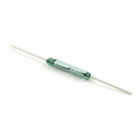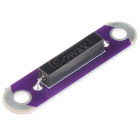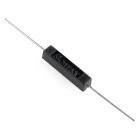Reed Switch Hookup Guide
Reed Switch Overview
Reed switches come in a variety of shapes and sizes. Through-hole, surface-mount, insulated, pre-formed -- there are a lot of factors to consider.
The basic glass reed switches are relatively fragile. If you're project will feature large magnets repeatedly slamming against the body of the switch, consider upgrading to an overmolded variant.
You may also need to consider the current and voltage capabilities of your reed switch -- they're usually not designed to carry a high amount of power. The glass switch we're using in this tutorial is rated for a maximum of 1.2A and 10W. Higher-power-capable switches are hard to find and can be expensive.
Normally Open, Normally Closed?
One thing all of these switches have in common is the two-terminal interface. But whether those terminals are normally open or closed is another question. The reed switch we'll be using in this example is normally-open. That means "normally", when the switch is unaffected by a magnetic field, the switch is open and does not conduct electricity. When a magnet comes close enough for the switch to activate, the contacts close and current can flow.
Magnetic Sensor Activation
Just as your magnet may have two poles, the reed switch's pair of ferrous contacts are also polarized. The position, distance, and orientation of your magnet all play a role in determining how the switch activates.
These example graphs, from the Hamlin App Note AN104 do a great job of demonstrating how the position of the magnet affects the activation of the switch.
The graph on the left shows an expected activation area when the magnet is held parallel to the reed switch. This area, as expected, is a mostly parabolic field. The graph on the right demonstrates what you can expect when the magnet is perpendicular to the switch. In this orientation, there is usually a dead zone in the center of the switch. If it's in the middle of the body, it might not activate, even when the magnet is touching the reed switch.
The polarity and position of the magnet plays an important role in how your reed switch activates. If your switch doesn't seem as sensitive as you'd like, try placing the magnet to one side or the other. Make sure you test the pair of components out before mounting either in place.




